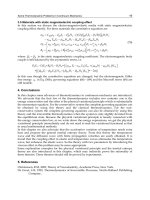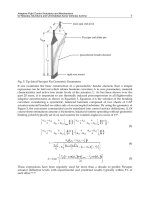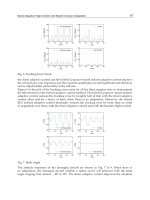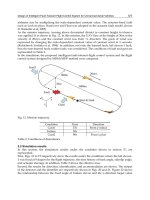Control Systems - Part 2 ppt
Bạn đang xem bản rút gọn của tài liệu. Xem và tải ngay bản đầy đủ của tài liệu tại đây (562.37 KB, 36 trang )
Classical
Controls
The classical method of controls involves
analysis and manipulation of systems in the
complex frequency domain. This domain,
entered into by applying the Laplace or
Fourier Transforms, is useful in examining
the characteristics of the system, and
determining the system response.
Pa
g
e 33 of 209Control S
y
stems/Print version - Wikibooks, collection of o
p
en-content textbooks
10/30/2006htt
p
://en.wikibooks.or
g
/w/index.
p
h
p
?title=Control
_
S
y
stems/Print
_
version&
p
rintable=
y
es
Transforms
Transforms
There are a number of transforms that we will be discussing throughout this book, and the reader is assumed to
have at least a small prior knowledge of them. It is not the intention of this book to teach the topic of transforms
to an audience that has had no previous exposure to them. However, we will include a brief refresher here to
refamiliarize people who maybe cannot remember the topic perfectly. If you do not know what the
Laplace
Transform
or the
Fourier Transform
are yet, it is highly recommended that you use this page as a simple guide,
and look the information up on other sources. Specifically, Wikipedia has lots of information on these subjects.
Laplace Transform
The
Laplace Transform
converts an equation from the time-domain into the so-called "S-domain", or the
Laplace domain
, or even the "Complex domain". These are all different names for the same mathematical space,
and they all may be used interchangably in this book, and in other texts on the subject. The Transform can only be
applied under the following conditions:
1. The system or signal in question is analog.
2. The system or signal in question is Linear.
3. The system or signal in question is Time-Invariant.
The transform is defined as such:
Laplace transform results have been tabulated extensively. More information on the Laplace transform, including
a transform table can be found in
the Appendix
.
If we have a linear differential equation in the time domain:
With zero initial conditions, we can take the Laplace transform of the equation as such:
And separating, we get:
Inverse La
p
lace Transform
[Laplace Transform]
Pa
g
e 34 of 209Control S
y
stems/Print version - Wikibooks, collection of o
p
en-content textbooks
10/30/2006htt
p
://en.wikibooks.or
g
/w/index.
p
h
p
?title=Control
_
S
y
stems/Print
_
version&
p
rintable=
y
es
The
inverse Laplace Transform
is defined as such:
The inverse transfrom converts a function from the Laplace domain back into the time domain.
Matrices and Vectors
The Laplace Transform can be used on systems of linear equations in an intuitive way. Let's say that we have a
system of linear equations:
We can arrange these equations into matrix form, as shown:
And write this symbolically as:
We can take the Laplace transform of both sides:
Which is the same as taking the transform of each individual equation in the system of equations.
Example: RL Circuit
Here, we are going to show a common example of a first-order
system, an
RL Circuit
. In an inductor, the relationship between
the current (i), and the voltage (v) in the time domain is expressed
as a derivative:
Where L is a special quantity called the "Inductance" that is a property of inductors.
[Inverse Laplace Transform]
For more information about electric
circuits, see:
Circuit Theory
Pa
g
e 35 of 209Control S
y
stems/Print version - Wikibooks, collection of o
p
en-content textbooks
10/30/2006htt
p
://en.wikibooks.or
g
/w/index.
p
h
p
?title=Control
_
S
y
stems/Print
_
version&
p
rintable=
y
es
Let's say that we have a 1st order RL series electric circuit. The resistor has resistance R, the inductor has
inductance L, and the voltage source has input voltage V
in
. The system output of our circuit is the voltage
over the inductor, V
out
. In the time domain, we have the following first-order differential equations to
describe the circuit:
However, since the circuit is essentially acting as a voltage divider, we can put the output in terms of the
input as follows:
This is a very complicated equation, and will be difficult to solve unless we employ the Laplace
transform:
We can divide top and bottom by L, and move V
in
to the other side:
And using a simple table look-up, we can solve this for the time-domain relationship between the circuit
input and the circuit output:
P
artial Fraction Expansion
L
aplace transform pairs are extensively tabulated, but frequently
w
e have transfer functions and other equations that do not have a
t
abulated inverse transform. If our equation is a fraction, we can
o
ften utilize
Partial Fraction Expansion
(PFE) to create a set of
s
impler terms that will have readily available inverse transforms.
T
his section is going to give a brief reminder about PFE, for those who have already learned the topic. This
r
efreshe
r
will be in the form of several examples of the process, as it relates to the Laplace Transform. People who
a
re unfamiliar with PFE are encouraged to read more about it in
Calculus
.
For more information about Partial
Fraction Expansion, see:
Calculus
Circuit diagram for the RL circuit example problem. V
L
is the
voltage over the inductor, and is the quantity we are trying to
find.
Pa
g
e 36 of 209Control S
y
stems/Print version - Wikibooks, collection of o
p
en-content textbooks
10/30/2006htt
p
://en.wikibooks.or
g
/w/index.
p
h
p
?title=Control
_
S
y
stems/Print
_
version&
p
rintable=
y
es
First Example
If we have a given equation in the s-domain:
We can expand it into several smaller fractions as such:
This looks impossible, because we have a single equation with 3 unknowns (s, A, B), but in reality s can
take any arbitrary value, and we can "plug in" values for s to solve for A and B, without needing other
equations. For instance, in the above equation, we can multiply through by the denominator, and cancel
terms:
Now, when we set s → -2, the A term disappears, and we are left with B → 3. When we set s → -1, we
can solve for A → -1. Putting these values back into our original equation, we have:
Remember, since the Laplace transform is a linear operator, the following relationship holds true:
Finding the inverse transform of these smaller terms should be an easier process then finding the inverse
transform of the whole function. Partial fraction expansion is a useful, and oftentimes necessary tool for
finding the inverse of an s-domain equation.
Second example
If we have a given equation in the s-domain:
We can expand it into several smaller fractions as such:
Pa
g
e 37 of 209Control S
y
stems/Print version - Wikibooks, collection of o
p
en-content textbooks
10/30/2006htt
p
://en.wikibooks.or
g
/w/index.
p
h
p
?title=Control
_
S
y
stems/Print
_
version&
p
rintable=
y
es
Canceling terms wouldn't be enough here, we will open the brackets:
Let's compare coefficients:
→
According to the Laplace Transform table:
Pa
g
e 38 of 209Control S
y
stems/Print version - Wikibooks, collection of o
p
en-content textbooks
10/30/2006htt
p
://en.wikibooks.or
g
/w/index.
p
h
p
?title=Control
_
S
y
stems/Print
_
version&
p
rintable=
y
es
Third example
(complex numbers):
When the solution of the denominator is a complex number, we use a complex representation "As + B",
like "3+i4"; in oppose to the use of a single letter (e.g. "D") - which is for real numbers:
We will need to reform it into two fractions that look like this (without changing its value):
→
→
Let's start with the denominator (for both fractions):
The roots of are
→
And now the numerators:
Pa
g
e 39 of 209Control S
y
stems/Print version - Wikibooks, collection of o
p
en-content textbooks
10/30/2006htt
p
://en.wikibooks.or
g
/w/index.
p
h
p
?title=Control
_
S
y
stems/Print
_
version&
p
rintable=
y
es
Inverse Laplace Transform:
Fourth example
:
And now for the "fitting":
The roots of are
No need to fit the fraction of D, because it is complete; no need to bother fitting the fraction of C, because
C is equal to zero.
Pa
g
e 40 of 209Control S
y
stems/Print version - Wikibooks, collection of o
p
en-content textbooks
10/30/2006htt
p
://en.wikibooks.or
g
/w/index.
p
h
p
?title=Control
_
S
y
stems/Print
_
version&
p
rintable=
y
es
F
inal Value Theorem
T
he
Final Value Theorem
allows us to determine the value of the time domain equation, as the time approaches
i
nfinity, from the S domain equation. In Control Engineering, the Final Value Theorem is used most frequently to
d
etermine the steady-state value of a system.
F
rom our chapter on system metrics, you may recognize the value of the system at time infinity as the steady-state
t
ime of the system. The difference between the steady state value, and the expected output value we remember as
b
eing the steady-state error of the system. Using the Final Value Theorem, we can find the steady-state value, and
t
he steady-state error of the system in the Complex S domain.
E
xample: Final Value Theorem
Find the final value of the following polynomial:
This is an admittedly simple example, because we can separate out the denominator into roots:
And we can cancel:
Now, we can apply the
Final Value Theorem
:
Using L'Hospital's rule (because this is an indeterminate form), we obtain the value:
[Final Value Theorem (Laplace)]
Pa
g
e 41 of 209Control S
y
stems/Print version - Wikibooks, collection of o
p
en-content textbooks
10/30/2006htt
p
://en.wikibooks.or
g
/w/index.
p
h
p
?title=Control
_
S
y
stems/Print
_
version&
p
rintable=
y
es
I
nitial Value Theorem
A
kin to the final value theorem, the
Initial Value Theorem
allows us to determine the initial value of the system
(
the value at time zero) from the S-Domain Equation. The initial value theorem is used most frequently to
d
etermine the starting conditions, or the "initial conditions" of a system.
C
ommon Transforms
W
e will now show you the transforms of the three functions we have already learned about: The unit step, the unit
r
amp, and the unit parabola. The transform of the unit step function is given by:
A
nd since the unit ramp is the integral of the unit step, we can multiply the above result times 1/s to get the
t
ransform of the unit ramp:
A
gain, we can multiply by 1/s to get the transform of the unit parabola:
F
ourier Transform
T
he
Fourier Transform
is very similar to the Laplace transform. The fourier transform uses the assumption that
a
ny finite time-domain can be broken into an infinite sum of sinusoidal (sine and cosine waves) signals. Under
t
his assumption, the Fourier Transform converts a time-domain signal into it's frequency-domain representation,
a
s a function of the radial frequency, . The Fourier Transform is defined as such:
W
e can now show that the Fourier Transform is equivalent to the Laplace transform, when the following conditio
n
i
s true:
[Initial Value Theorem (Laplace)]
[Fourier Transform]
Pa
g
e 42 of 209Control S
y
stems/Print version - Wikibooks, collection of o
p
en-content textbooks
10/30/2006htt
p
://en.wikibooks.or
g
/w/index.
p
h
p
?title=Control
_
S
y
stems/Print
_
version&
p
rintable=
y
es
Because the Laplace and Fourier Transforms are so closely related, it does not make much sense to use both
transforms for all problems. This book, therefore, will concentrate on the Laplace transform for nearly all
subjects, except those problems that deal directly with frequency values. For frequency problems, it makes life
much easier to use the Fourier Transform representation.
Like the Laplace Transform, the Fourier Transform has been extensively tabulated. Properties of the Fourier
transform, in addition to a table of common transforms is available in
the Appendix
.
Inverse Fourier Transform
The
inverse Fourier Transform
is defined as follows:
This transform is nearly identical to the Fourier Transform.
Complex Plane
Using the above equivalence, we can show that the Laplace transform is always equal to the Fourier Transform, if
the variable s is an imaginary number. However, the Laplace transform is different if s is a real or a complex
variable. As such, we generally define s to have both a real part and an imaginary part, as such:
And we can show that
, if
Since the variable s can be broken down into 2 independant values, it is frequently of some value to graph the
variable s on it's own special "S-plane". The S-plane graphs the variable σ on the horizontal axis, and the value of
j
ω on the vertical axis.
Euler's Formula
There is an important result from calculus that is known as
Euler's Formula
, or "Euler's Relation". This
important formula relates the important values of e, j, π, 1 and 0:
However, this result is derived from the following equation, setting ω to π:
[Inverse Fourier Transform]
Pa
g
e 43 of 209Control S
y
stems/Print version - Wikibooks, collection of o
p
en-content textbooks
10/30/2006htt
p
://en.wikibooks.or
g
/w/index.
p
h
p
?title=Control
_
S
y
stems/Print
_
version&
p
rintable=
y
es
This formula will be used extensively in some of the chapters of this book, so it is
important to become familiar with it now.
Further Reading
Digital Signal Processing/Continuous-Time Fourier Transform
Signals and Systems/Aperiodic Signals
Circuit Theory/Laplace Transform
[Euler's Formula]
Pa
g
e 44 of 209Control S
y
stems/Print version - Wikibooks, collection of o
p
en-content textbooks
10/30/2006htt
p
://en.wikibooks.or
g
/w/index.
p
h
p
?title=Control
_
S
y
stems/Print
_
version&
p
rintable=
y
es
Transfer Functions
Transfer Functions
A
Transfer Function
is the ratio of the output of a system to the input of a system, in the Laplace domain. If we
have an input function of X(s), and an output function Y(s), we define the transfer function H(s) to be:
Readers who have read the Circuit Theory book will recognize the tranfer function as being the Laplace transform
of a circuit's impulse response.
Impulse Response
For comparison, we will consider the time-domain equivalent to
the above input/output relationship. In the time domain, we
generally denote the input to a system as x(t), and the output of the
system as y(t). The relationship between the input and the output is
denoted as the
impulse response
, h(t).
We define the impulse response as being the relationship between
the system output to it's input. We can use the following equation
to define the impulse response:
Impulse Function
It would be handy at this point to define precisely what an "impulse" is. The
Impulse Function
, denoted with δ(t)
is a special function defined peice-wise as follows:
An examination of the impulse function will show that it is related to the unit-step function as follows:
[Transfer Function]
Note:
:
Time domain variables are generally
written with lower-case letters. Laplace-
Domain, and other transform domain
variables are generally written using
upper-case letters.
[Impulse Function]
Pa
g
e 45 of 209Control S
y
stems/Print version - Wikibooks, collection of o
p
en-content textbooks
10/30/2006htt
p
://en.wikibooks.or
g
/w/index.
p
h
p
?title=Control
_
S
y
stems/Print
_
version&
p
rintable=
y
es
and
The impulse function is not defined at point t = 0, but the impulse response must always satisfy the following
condition, or else it is not a true impulse function:
The response of a system to an impulse input is called the
impulse response
. Now, to get the Laplace Transform
of the impulse function, we take the derivative of the unit step function, which means we multiply the transform
of the unit step function by s:
This result can be verified in the transform tables in
The Appendix
.
Convolution
However, the impulse response cannot be used to find the system output from the system input in the same
manner as the transfer function. If we have the system input and the impulse response of the system, we can
calculate the system output using the convolution operation as such:
Where " * " (asterisk) denotes the convolution operation.
Convolution is a complicated combination of multiplication,
integration and time-shifting. We can define the convolution
between two functions, a(t) and b(t) as the following:
(The variable τ (greek tau) is a dummy variable for integration). This operation can be difficult to perform.
Therefore, many people prefer to use the Laplace Transform (or another transform) to convert the convolution
operation into a multiplication operation, through the
Convolution Theorem
.
Time-Invariant System Response
If the system in question is time-invariant, then the general description of the system can be replaced by a
Remember: an asterisk means
convolution
, not
multiplication
!
[Convolution]
Pa
g
e 46 of 209Control S
y
stems/Print version - Wikibooks, collection of o
p
en-content textbooks
10/30/2006htt
p
://en.wikibooks.or
g
/w/index.
p
h
p
?title=Control
_
S
y
stems/Print
_
version&
p
rintable=
y
es
convolution integral of the system's impulse response and the system input. We can call this the
convolution
description
of a system, and define it below:
Convolution Theorem
This method of solving for the output of a system is quite tedious, and in fact it can waste a large amount of time
if you want to solve a system for a variety of input signals. Luckily, the Laplace transform has a special property,
called the
Convolution Theorem
, that makes the operation of convolution easier:
Convolution Theorem
Convolution in the time domain becomes multiplication in the complex Laplace domain.
Multiplication in the time domain becomes convolution in the complex Laplace domain.
The Convolution Theorem can be expressed using the following equations:
This also serves as a good example of the property of
Duality
.
Using the Transfer Function
The Transfer Function fully decribes a control system. The Order, Type and Frequency response can all be taken
from this specific function. Nyquist and Bode plots can be drawn from the open loop Transfer Function. These
p
lots show the stability of the system when the loop is closed. Using the denominator of the transfer function,
called the characteristic equation the roots of the system can be derived.
For all these reasons and more, the Transfer function is an important aspect of classical control systems. Let's start
out with the definition:
Transfer Function
The Transfer function of a system is the relationship of the system's output to it's input,
represented in the complex Laplace domain.
If the complex Laplace variable is 's', then we generally denote the transfer function of a system as either G(s) or
H(s). If the system input is X(s), and the system output is Y(s), then the transfer function can be defined as such:
[Convolution Description]
[Convolution Theorem]
Pa
g
e 47 of 209Control S
y
stems/Print version - Wikibooks, collection of o
p
en-content textbooks
10/30/2006htt
p
://en.wikibooks.or
g
/w/index.
p
h
p
?title=Control
_
S
y
stems/Print
_
version&
p
rintable=
y
es
If we know the input to a given system, and we have the transfer function of the system, we can solve for the
system output by multiplying:
Example: Impulse Response
From a Laplace transform table, we know that the Laplace transform of the impulse function, δ(t) is:
So, when we plug this result into our relationship between the input, output, and transfer function, we
get:
In other words, the "impulse response" is the output of the system when we input an impulse function.
Example: Step Response
From the Laplace Transform table, we can also see that the transform of the unit step function, u(t) is
given by:
Plugging that result into our relation for the transfer function gives us:
And we can see that the step response is simply the impulse response divided by s.
Frequency Response
The
Frequency Response
is similar to the Transfer function, except that it is the relationship between the system
[Transfer Function Description]
Pa
g
e 48 of 209Control S
y
stems/Print version - Wikibooks, collection of o
p
en-content textbooks
10/30/2006htt
p
://en.wikibooks.or
g
/w/index.
p
h
p
?title=Control
_
S
y
stems/Print
_
version&
p
rintable=
y
es
output and input in the complex Fourier Domain, not the Laplace domain. We can obtain the frequency response
from the transfer function, by using the following change of variables:
Frequency Response
The frequency response of a system is the relationship of the system's output to it's input,
represented in the Fourier Domain.
Pa
g
e 49 of 209Control S
y
stems/Print version - Wikibooks, collection of o
p
en-content textbooks
10/30/2006htt
p
://en.wikibooks.or
g
/w/index.
p
h
p
?title=Control
_
S
y
stems/Print
_
version&
p
rintable=
y
es
Sampled Data Systems
Ideal Sampler
In this chapter, we are going to introduce the ideal sampler and the
Star Transform
. First, we need to introduce
(or review) the
Geometric Series
infinite sum. The results of this sum will be very useful in calculating the Star
Transform, later.
Consider a sampler device that operates as follows: every T seconds, the sampler reads the current value of the
input signal at that exact moment. The sampler then holds that value on the output for T seconds, before taking
the next sample. We have a generic input to this system, f(t), and our sampled output will be denoted f*(t). We
can then show the following relationship between the two signals:
f*(t) = f(0)(u(0) - u(T)) + f(T)(u(T) - u(2T)) +
N
ote that the value of f* at time t = 1.5T = T. This relationship works fo
r
any fractional value.
Taking the Laplace Transform of this infinite sequence will yield us with a special result called the
Star
Transform
. The Star Transform is also occasionally called the "Starred Transform" in some texts.
Geometric Series
Before we talk about the Star Transform or even the Z-Transform, it is useful for us to review the mathematical
background behind solving infinite series. Specifically, because of the nature of these transforms, we are going to
look at methods to solve for the sum of a
geometric series
.
A geometic series is a sum of values with increasing exponents, as such:
In the equation above, notice that each term in the series has a coefficient value, a. We can optionally factor out
this coefficient, if the resulting equation is easier to work with:
Once we have an infinite series in either of these formats, we can conveniently solve for the total sum of this
series using the following equation:
Let's say that we start our series off at a number that isn't zero. Let's say for instance that we start our series off at
n=1 or n=100. Let's see:
Pa
g
e 50 of 209Control S
y
stems/Print version - Wikibooks, collection of o
p
en-content textbooks
10/30/2006htt
p
://en.wikibooks.or
g
/w/index.
p
h
p
?title=Control
_
S
y
stems/Print
_
version&
p
rintable=
y
es
We can generalize the sum to this series as follows:
With that result out of the way, now we need to worry about making this series converge. In the above sum, we
know that n is approaching infinity (because this is an infinite sum). Therefore, any term that contains the variable
n is a matter of worry when we are trying to make this series converge. If we examine the above equation, we see
that there is one term in the entire result with an n in it, and from that, we can set a fundamental inequality to
govern the geometric series.
To satisfy this equation, we must satisfy the following condition:
Therefore, we come to the final result:
The geometric series converges if and only if the value of r is less than
one.
The Star Transform
The
Star Transform
is defined as such:
The Star Transform depends on the sampling time, T, and is different for a single signal, depending on the speed
at which the signal is sampled. Since the Star Transform is defined as an infinite series, it is important to note that
some inputs to the Star Transform will not converge, and therefore some functions do not have a valid Star
Transform. Also, it is important to note that the Star Transform may only be valid under a particular region of
convergance. We will cover this topic more when we discuss the Z-transform.
Star ↔ Laplace
The Laplace transform and the Star transform are clearly related, because we obtained the Star Transform by
using the Laplace transform on a time-domain signal. However, the method to convert between the two results
can be a slightly difficult one. To find the Star Transform of a Laplace function, we must take the residues of the
Laplace equation, as such:
[Geometric Series]
[Geometric convergence condition]
[Star Transform]
Pa
g
e 51 of 209Control S
y
stems/Print version - Wikibooks, collection of o
p
en-content textbooks
10/30/2006htt
p
://en.wikibooks.or
g
/w/index.
p
h
p
?title=Control
_
S
y
stems/Print
_
version&
p
rintable=
y
es
This math is advanced for most readers, so we can also use an alternate method, as follows:
N
either one of these methods are particularly easy, however, and therefore we will not discuss the relationship
between the Laplace transform and the Star Transform any more then is absolutely necessary in this book. Suffice
it to say, however, that the Laplace transform and the Star Transform are related mathematically.
Star + Laplace
In some systems, we may have components that are both continuous and discrete in nature. For instance, if our
feedback loop consists of an Analog-To-Digital converter, followed by a computer (for processing), and then a
Digital-To-Analog converter. In this case, the computer is acting on a digital signal, but the rest of the system is
acting on continuous signals. Star transforms can interact with Laplace transforms in some of the following ways:
Given:
Then:
Given:
Then:
Where is the Star Transform of the product of X(s)H(s).
Convergence of the Star Transform
The Star Transform is defined as being an infinite series, so it is critically important that the series converge (not
reach infinity), or else the result will be nonsensical. Since the Star Transform is a geometic series (for many input
signals), we can use geometric series analysis to show whether the series converges, and even under what
p
articular conditions the series converges.
Pa
g
e 52 of 209Control S
y
stems/Print version - Wikibooks, collection of o
p
en-content textbooks
10/30/2006htt
p
://en.wikibooks.or
g
/w/index.
p
h
p
?title=Control
_
S
y
stems/Print
_
version&
p
rintable=
y
es
The Z-Transform
Let us say now that we have a discrete data set that is sampled at regular intervals. We can call this set x[n]:
x[n] = [ x[0] x[1] x[2] x[3] x[4] ]
we can utilize a special transform, called the Z-transform, to make
dealing with this set more easy:
Like the Star Transform, the Z Transform is defined as an infinite
series, and therefore we need to worry about convergance. In fact,
there are a number of instances that have identical Z-Transforms,
but different regions of convergance (ROC). Therefore, when
talking about the Z transform, you must include the ROC, or you
are missing valuable information.
Inverse Z Transform
The
inverse Z Transform
is defined by the following path integral:
This integral is sufficiently complicated that we won't discuss it any further in this book. There are a number of Z-
transform pairs available in table form in
The Appendix
.
Final Value Theorem
Like the Laplace Transform, the Z Transform also has an associated final value theorem:
This equation can be used in the same way that the other equation can be used.
Star ↔ Z
The Z transform is related to the Star transform though the following change of variables:
This is also known as the
Bilateral Z-
Transform
. We will only discuss this
version of the transform in this book
[Z Transform]
Z-Transform properties, and a table of
common transforms can be found in:
the Appendix
.
[Inverse Z Transform]
[Final Value Theorem (Z)]
Pa
g
e 53 of 209Control S
y
stems/Print version - Wikibooks, collection of o
p
en-content textbooks
10/30/2006htt
p
://en.wikibooks.or
g
/w/index.
p
h
p
?title=Control
_
S
y
stems/Print
_
version&
p
rintable=
y
es
N
otice that in the Z domain, we don't maintain any information on the sampling period, so converting to the Z
domain from a Star Transformed signal loses that information. When converting back to the star domain however,
the value for T can be re-insterted into the equation, if it is still available.
Also of some importance is the fact that the Z transform is bilinear, while the Star Transform is unilinear. This
means that we can only convert between the two transforms if the sampled signal is zero for all values of n < 0.
Because the two transforms are so closely related, it can be said that the Z transform is simply a notational
convenience for the Star Transform. With that said, this book could easily use the Star Transform for all
p
roblems, and ignore the added burden of Z transform notation entirely. A common example of this is Richard
Hamming's book "Numerical Methods for Scientists and Engineers" which uses the Fourier Transform for all
p
roblems, considering the Laplace, Star, and Z-Transforms to be merely notational conveniences. However, the
Control Systems wikibook is under the impression that the correct utilization of different transforms can make
p
roblems more easy to solve, and we will therefore use a multi-transform approach.
Z plane
Z is a complex variable with a real part and an imaginary part. In other words, we can define Z as such:
Since Z can be broken down into two independant components, it often makes sense to graph the variable z on the
z-plane
. In the z-plane, the horizontal axis represents the real part of z, and the vertical axis represents the
magnitude of the imaginary part of z.
N
otice also that if we define z in terms of the sta
r
-transfrom relation:
we can separate out s into real and imaginary parts:
We can plug this into our equation for z:
Through
Euler's formula
, we can separate out the complex exponential as such:
If we define two new variables, M and φ:
Pa
g
e 54 of 209Control S
y
stems/Print version - Wikibooks, collection of o
p
en-content textbooks
10/30/2006htt
p
://en.wikibooks.or
g
/w/index.
p
h
p
?title=Control
_
S
y
stems/Print
_
version&
p
rintable=
y
es
We can write z in terms of M and φ. Notice that it is euler's equation:
Which is clearly a polar representation of z, with the magnitude of the polar function (M) based on the real-part of
s, and the angle of the polar function (φ) is based on the imaginary part of s.
Region of Convergence
To best teach the region of convergance (ROC) for the Z-transform, we will do a quick example.
We have the following discrete series or a decaying exponential:
Now, we can plug this function into the Z transform equation:
Note that we can remove the unit step function, and change the limits of the sum:
This is because the series is 0 for all time less then n → 0. If we try to combine the n terms, we get the
following result:
Once we have our series in this term, we can break this down to look like our geometric series:
And finally, we can find our final value, using the geometric series formula:
Again, we know that to make this series converge, we need to make the r value less then 1:
Pa
g
e 55 of 209Control S
y
stems/Print version - Wikibooks, collection of o
p
en-content textbooks
10/30/2006htt
p
://en.wikibooks.or
g
/w/index.
p
h
p
?title=Control
_
S
y
stems/Print
_
version&
p
rintable=
y
es
And finally we obtain the region of convergance for this Z-transform:
N
ote
: z and s are complex variables, and therefore we need to take the magnitude in our ROC calculations. The
"
Absolute Value symbols" are actually the "magnitude calculation", and is defined as such:
I
nverse Z Transform
T
he
inverse Z-Transform
is defined as:
W
here is a counterclockwise closed path encircling the origin and entirely in the region of convergence (ROC).
T
he contour or path, , must encircle all of the poles of .
T
his math is relatively advanced compared to some other material in this book, and therefore little or no further
a
ttention will be paid to solving the inverse Z-Transform in this manner. Z transform pairs are heavily tabulated in
r
eference texts, so many readers can consider that to be the primary method of solving for inverse Z transforms.
L
aplace ↔ Z
T
here are no easy, direct ways to convert between the Laplace transform and the Z transform directly. Nearly all
m
ethods of conversions reproduce some aspects of the original equation faithfully, and incorrectly reproduce othe
r
a
spects. For some of the main mapping techniques between the two, see the Z Transform Mappings Appendix.
H
owever, there are some topics that we need to discuss. First and foremost, conversions between the Laplace
d
omain and the Z domain are not linear, this leads to some of the following problems:
1.
2.
T
his means that when we combine two functions in one domain multiplicatively, we must find a combined
t
ransform in the other domain. Here is how we denote this combined transform:
[Inverse Z Transform]
Pa
g
e 56 of 209Control S
y
stems/Print version - Wikibooks, collection of o
p
en-content textbooks
10/30/2006htt
p
://en.wikibooks.or
g
/w/index.
p
h
p
?title=Control
_
S
y
stems/Print
_
version&
p
rintable=
y
es
N
otice that we use a horizontal bar over top of the multiplied functions, to denote that we took the transform of
the product, not of the individual peices. However, if we have a system that incorporates a sampler, we can show
a simple result. If we have the following format:
Then we can put everything in terms of the Star Transform:
and once we are in the star domain, we can do a direct change of variables to reach the Z domain:
N
ote that we can only make this equivalence relationship if the system incorporates an ideal sampler, and
therefore one of the multiplicative terms is in the star domain.
Example
Let's say that we have the following equation in the Laplace domain:
And because we have a discrete sampler in the system, we want to analyze it in the Z domain. We can
break up this equation into two separate terms, and transform each:
And
And when we add them together, we get our result:
Reconstruction
Some of the easiest reconstruction circuits are called "Holding circuits". Once a signal has been transformed using
the Star Transform (passed through an ideal sampler), the signal must be "reconstructed" using one of these hold
systems (or an equivalent) before it can be analyzed in a Laplace-domain system.
Pa
g
e 57 of 209Control S
y
stems/Print version - Wikibooks, collection of o
p
en-content textbooks
10/30/2006htt
p
://en.wikibooks.or
g
/w/index.
p
h
p
?title=Control
_
S
y
stems/Print
_
version&
p
rintable=
y
es









